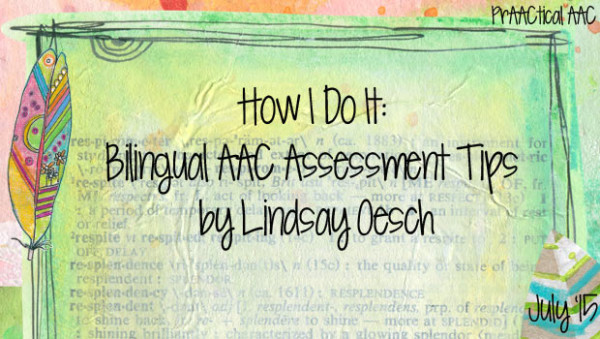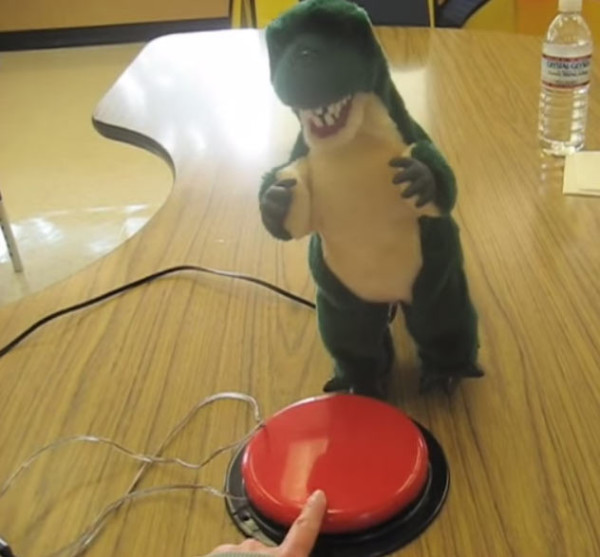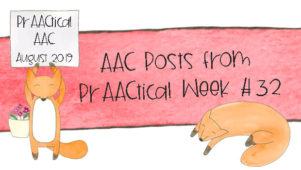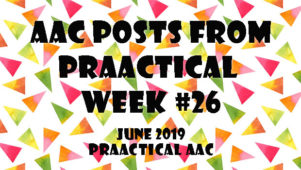How I Do It: Bilingual AAC Assessment Tips by Lindsay Oesch

One of the things that I love most about where I live is the rich mix of cultural heritages and linguistic backgrounds in the clients we serve. It can be challenging to do a good assessment, though. Today, we hear from Lindsay Oesch who shares her thoughts on AAC assessments with children from bilingual environments. Don’t miss clicking through to get the parent questionnaires and other resources she shares in her post.
can be challenging to do a good assessment, though. Today, we hear from Lindsay Oesch who shares her thoughts on AAC assessments with children from bilingual environments. Don’t miss clicking through to get the parent questionnaires and other resources she shares in her post.
::::::::::::::::::::::::::::::::::::::::::::::
Beginning the AAC Assessment Process with Bilingual Children
As a clinician in New York City, it is so exciting to be working with children ages 5-12 as a speech-language pathologist in one of the most culturally and linguistically dynamic places in the world. It has also remained a major challenge to assess and treat children with speech and language impairment/delay who speak more than one language, in order to accommodate their specific language needs.
Assessment for a communication device is a thorough process, requiring a team of not only professionals (teacher, speech-language pathologist, occupational therapist, physical therapist, social worker, etc.) but perhaps most importantly, the people who are familiar with the child’s communication in everyday environments. The parents, siblings, friends of family often have extremely valuable input. There may also be a language barrier when working with these key people that needs to be addressed.
Here are a few quick pointers that I have found to be helpful while working with multilingual families during the assessment process for an AAC device/board, in order to best meet the needs of the child and to assist in successful use of it in both in home and school environments. Some materials will be provided in French; however, the focus will mostly be on the Spanish language.
Eliminating Misconceptions with Evidence Based Practice (EBP)
Will AAC negatively affect the development of my child’s language?
One of the most common misconceptions around is that an AAC device will prevent a child from acquiring speech. We may hear this one quite a bit, and that’s OK. It’s our job to clarify by providing information so that we can move forward and collaborate, hopefully by increasing use in the home environment. AAC devices have only been around for approximately three decades and may be somewhat unheard of still in many parts of the world. Providing information in the home language can help caregivers to understand the purpose.
This is an effective resource in Spanish that explains how AAC devices may be useful for individuals with speech and language impairment as well as delays. This information from the Vanderbilt Kennedy Center also explains that there is no evidence which supports the notion that AAC prevents speech and language acquisition.
Providing as much EBP in the home language as possible will help get the family on board, hopefully increasing use in the home. I found this EBP to be especially useful when the child is minimally verbal and there may be a doubt as to whether or not the device is necessary. In this case, the device is an additional support and this can be explained on the ASHA website as well, in Spanish.
“Las personas que utilizan los sistemas aumentativos y alternativos de comunicación no deben de dejar de hablar si son capaces de hacerlo. Estos instrumentos están encaminados a ayudarlos a comunicarse con mayor eficacia.”
(People who use the augmentative alternative communication systems do not need to stop speaking if they are capable of doing so. These instruments are on target to help these individuals communicate with improved efficiency.)
Assessment Items
What Objects/Food Items Should be Used When Evaluating Multilingual Children?
During an evaluation, there will be an assessment to determine if the child understands basic cause and effect. This is one of the first steps to determining if a child is ready to use an AAC device. The child may demonstrate some understanding that if I touch a photo of a food item that I want, for example, I will get that food item. It is essential that, whenever possible, caregivers are a part of this process in order to comment on their interactions with the child. I always ask that parents, siblings, etc. get on board by bringing in items from home that the child enjoys so that interaction with all preferred objects may be assessed . Children from different cultures for example, who may enjoy interacting with bubbles in the speech room might react with increased excitement when they hear music from their home country on a familiar radio from their kitchen. It’s a fun process and it shows the family members that the device can be used at home to request items that are familiar. It also shows family members that their input and the home environment is a valuable and important piece during the AAC evaluation process. They will witness specific examples of how to use those items with an AAC device in the home, which will improve carry-over.
Video Credit: Dawn Wee
This video captures the use of a switch, which is a useful AAC device for many children who are new to AAC use. The switch can be hooked up to toys and home items like radios. The child may then work on requesting to use these preferred items with improved volition.
For caregivers and professionals who are not sure of what to use when working on cause/effect understanding with multilingual children, there are a few free apps from Moo Moo Lab that are recommended when working on cause/effect. Both First Vehicles and Animal World are available in English, French, Japanese, Mandarin, and Spanish.
Caregiver Survey
If the caregiver is not able to come to the evaluation, sending home an informal survey may be quite useful. Here is one in French and in one in Spanish, with English translations, which are both included here. They are intentionally brief, as to not overwhelm the caregiver, but rather receive a few pieces of essential information about what the child does at home to request, protest, etc.
How Should the Home Language Be Incorporated into The Evaluation?
Many children demonstrate language dominance. Even children who are not yet verbal will sometimes increase eye contact and smile more when hearing familiar articulation patterns and intonation. Getting caregivers to speak the home language with the child during the evaluation is great, because they are a familiar voice paired with a familiar language. The child’s language abilities may differ substantially in the home language.
Multilingual Materials
Create all AAC materials in both languages whenever possible. Core vocabulary words that are functional (i.e. more, hi, bye) usually work the best across multiple environments and are a great starting point for many children. For some tips on what types of words to use, see this post.
::::::::::::::::::::::::
Lindsay Oesch, M.S. CF-SLP is employed by the NYC Department of Education and just completed her first school year at a special needs school in the Bronx. She currently holds a Teacher of Students with Speech and Language Disabilities (TSSLD) certification with a Bilingual Extension in French and Spanish. She has used many different types of static/dynamic display communication devices when working with children and adults, including switches, 1, 4, 8, 20, 32 cell static display voice output devices and dynamic display devices, some of which include the LAMP app. Prior to working as a speech-language pathologist, Lindsay was a Medicaid Service Coordinator, locating services and providing support for both monolingual/bilingual children and adults with disabilities in New York City.
Filed under: PrAACtical Thinking
Tagged With: assessment, bilingual, download, Lindsay Oesch, resources
This post was written by Carole Zangari






3 Comments
Thank you Lindsay for sharing such practical and important information!
A-MAZ-ING!!!!! I’m looking into developing materials for bilingual (Spanish/English) population and found your post very helpful! I’d love to ask you some questions if you wouldn’t mind. Would it be possible to email you? Thank you very much!!!!!
Gloria – Thank you for the positive feedback and kind words.
Karen – Thank you. Would be happy to help. You can email any questions to bilingualspeechtherapist@gmail.com.